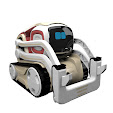Lego: from the craft of carpenter to leadership in the world of toys
What is the most famous designer in the world? Of course Lego! And what is the most famous platform for learning robotics? Of course Lego Mindstorms! We will understand why. Lego was founded in 1932. Its founder is Danish Ole Kirk Christiansen. Being a carpenter, he first founded a company for the production of products for the home and later engaged in the production of wooden cubes for children.
The company was named Lego, connecting the Danish word leg to play and got good. In 1947, the company Lego began producing plastic toys and in 1949 the famous snap Lego bricks appeared. The main ideas of Lego are modularity and compatibility. Although the bricks in 65 years of their existence have changed the design and shape, they are absolutely compatible with each other. Modern elements may well be added to the elements 40 years ago.
Today, the scope of activity of Lego is certainly much wider than the production of toys. The company creates clothes, films, games, organizes contests, including robotic ones. In the world, Lego museums have opened theme amusement parks - Legoland, which is almost entirely built of Lego cubes. From Lego, you can collect models of cars, airplanes, ships, buildings, and, of course, robots. Since the end of the last century, Lego has released a special robotic constructor, which today has become the leader in educational robotics.
Lego Mindstorms: robotics for everyone
The idea to add an electronic programmable unit, sensors and electric motors to Lego standard parts, to make programming easy and understandable for children, and to develop a special designer to create robots has revived not only Lego-designs but the entire company. Since 1991, the company has suffered losses for 11 years in a row. And it was precisely the robotic direction that saved the situation. For the first time, the robotic designer Lego Mindstorms was introduced in 1998. In 2006, the second version of the constructor, NXT, was released, and in early 2013, EV3 appeared (short for Evolution 3).
The heart of the designer is a microcomputer (microcontroller), also known as a P-brick, or P-brick (from the Programmable brick, a programmable brick). Standard Lego parts (beams, gears, axles, wheels) change little with the development of the designer, the microcomputer undergoes the greatest changes.
The first version of the designer was equipped with the RCX microcomputer, the second - with the NXT, and as part of the modern version - the EV3. With the development of the designer, the manufacturer adheres to the policy of backward compatibility, i.e. Details from older versions can be shared with the new designer. For example, sensors from the NXT version can be used with the EV3. The development of the designer in step with the times is first of all the development of the microcomputer and the programming environment. An important difference in the modern EV3 unit is that it runs on the free Linux operating system.








